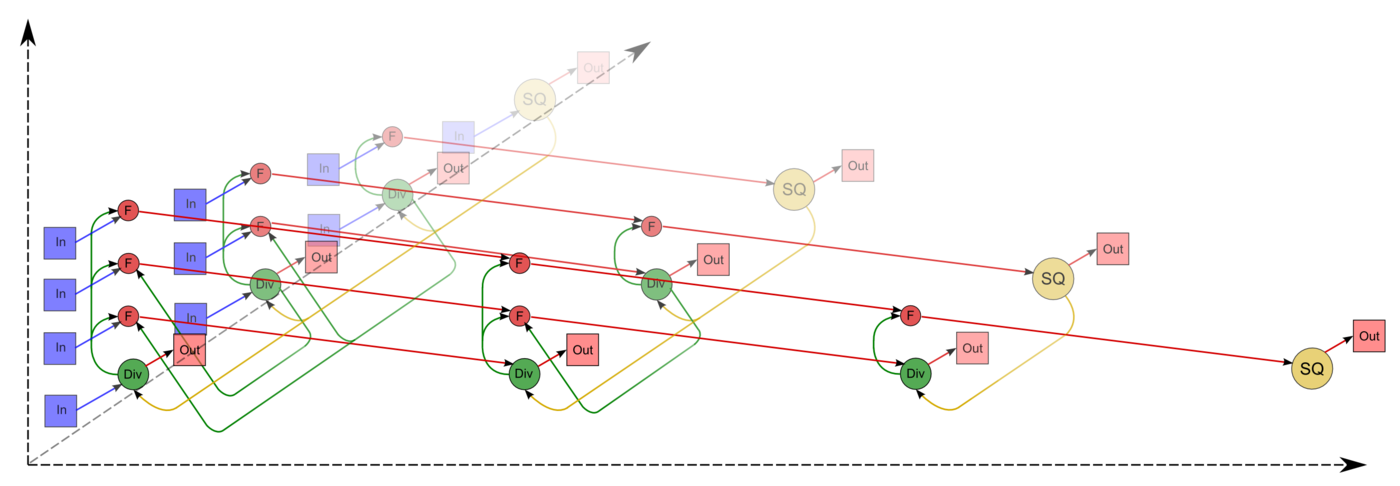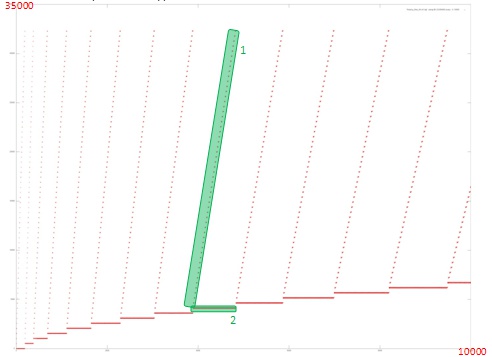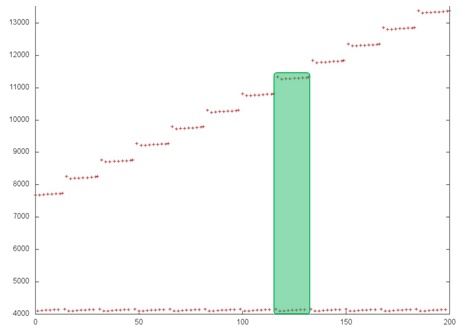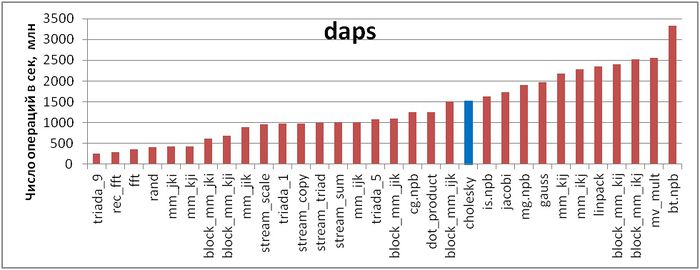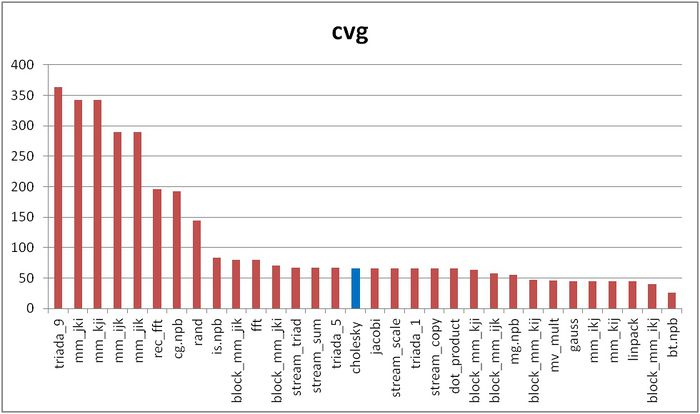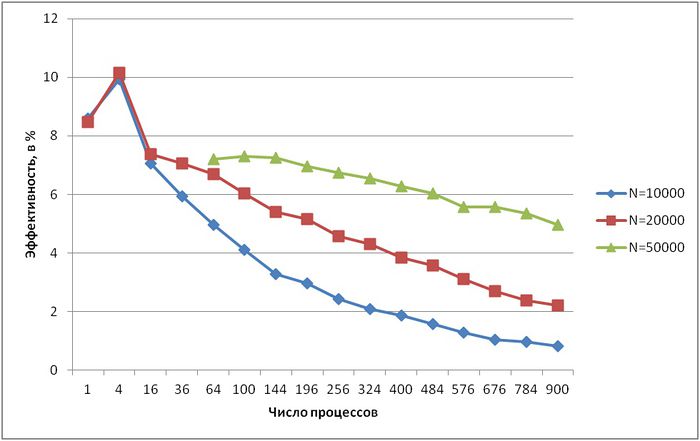Difference between revisions of "Cholesky decomposition"
| [unchecked revision] | [unchecked revision] |
| Line 305: | Line 305: | ||
==== Scalability of a particular implementation ==== | ==== Scalability of a particular implementation ==== | ||
| − | Let us perform a scalability analysis of a particular implementation of the Cholesky algorithm according to the [[Scalability methodology|scalability methodology]] with the use of the [http://parallel.ru/cluster Lomonosov supercomputer installed at the Research Computing Center of Moscow State University | + | Let us perform a scalability analysis of a particular implementation of the Cholesky algorithm according to the [[Scalability methodology|scalability methodology]] with the use of the [http://parallel.ru/cluster Lomonosov supercomputer installed at the Research Computing Center of Moscow State University]. |
[[Glossary#Startup parameters|Startup parameters]]: | [[Glossary#Startup parameters|Startup parameters]]: | ||
Revision as of 10:30, 11 March 2015
|
Properties of the algorithm:
|
Contents
- 1 Properties and structure of the algorithm
- 1.1 General description
- 1.2 Mathematical description
- 1.3 Computational kernel of the Cholesky algorithm
- 1.4 Macrostructure of the Cholesky algorithm
- 1.5 The implementation scheme of the sequential algorithm
- 1.6 Sequential complexity of the algorithm
- 1.7 Information graph
- 1.8 Parallelization resources of the algorithm
- 1.9 Input and output data of the algorithm
- 1.10 Properties of the algorithm
- 2 Software implementation
- 2.1 Implementation peculiarities of the sequential algorithm
- 2.2 Locality of data and computations
- 2.3 Approaches and features of implementing the Cholesky algorithm in parallel
- 2.4 Scalability of the Cholesky algorithm and its implementations
- 2.5 Dynamic characteristics and performance efficiency
- 2.6 Выводы для классов архитектур
- 2.7 Существующие реализации алгоритма
- 3 Литература
1 Properties and structure of the algorithm
1.1 General description
The Cholesky decomposition algorithm was first proposed by Andre-Louis Cholesky (October 15, 1875 - August 31, 1918) at the end of the First World War shortly before he was killed in battle. He was a French military officer and mathematician. The idea of this algorithm was published in 1924 by his fellow officer and, later, was used by Banachiewicz in 1938 [7]. In the Russian mathematical literature, the Cholesky decomposition is also known as the square-root method [1-3] due to the square root operations used in this decomposition and not used in Gaussian elimination.
Originally, the Cholesky decomposition was used only for dense symmetric positive definite matrices. At present, the application of this decomposition is much wider. For example, it can also be employed for the case of Hermitian matrices. In order to increase the computing performance, its block versions are often applied.
In the case of sparse matrices, the Cholesky decomposition is also widely used as the main stage of a direct method for solving linear systems. In order to reduce the memory requirements and the profile of the matrix, special reordering strategies are applied to minimize the number of arithmetic operations. A number of reordering strategies are used to identify the independent matrix blocks for parallel computing systems.
Various versions of the Cholesky decomposition are successfully used in iterative methods to construct preconditioners for sparse symmetric positive definite matrices. In the case of incomplete triangular decomposition, the elements of a preconditioning matrix are specified only in predetermined positions (for example, in the positions of the nonzero elements; this version is known as the IC0 decomposition). In order to construct a more accurate decomposition, a filtration of small elements is performed using a filtration threshold. The use of such a threshold allows one to obtain an accurate decomposition, but the number of nonzero elements increases. A decomposition algorithm of second-order accuracy is discussed in [11]; this algorithm retains the number of nonzero elements in the factors of the decomposition and allows one to increase the accuracy. In its parallel implementation, a special version of an additive preconditioner is applied on the basis of the second-order decomposition [12].
Here we consider the original version of the Cholesky decomposition for dense real symmetric positive definite matrices. For a number of other versions, however, the structure of this decomposition is almost the same (for example, for the complex case): the distinctions consist in the change of most real operations by the corresponding complex operations. A list of other basic versions of the Cholesky decomposition is available on the page The Cholesky method (symmetric triangular decomposition).
For positive definite Hermitian matrices (symmetric matrices in the real case), we use the decomposition A = L L^*, where L is the lower triangular matrix, or the decomposition A = U^* U, where U is the upper triangular matrix. These forms of the Cholesky decomposition are equivalent in the sense of the amount of arithmetic operations and are different in the sense of data represntation. The essence of this decomposition consists in the implementation of formulas obtained uniquely for the elements of the matrix L form the above equality. The Cholesky decomposition is widely used due to the following features.
1.1.1 Symmetry of matrices
The symmetry of a matrix allows one to store in computer memory slightly more than half the number of its elements and to reduce the number of operations by a factor of two compared to Gaussian elimination. Note that the LU-decomposition does not require the square-root operations when using the property of symmetry and, hence, is somewhat faster than the Cholesky decomposition, but requires to store the entire matrix.
1.1.2 Accumulation mode
The Cholesky decomposition allows one to use the so-called accumulation mode due to the fact that the significant part of computation involves dot product operations. Hence, these dot products can be accumulated in double precision for additional accuracy. In this mode, the Cholesky method has the least equivalent perturbation. During the process of decomposition, no growth of the matrix elements can occur, since the matrix is symmetric and positive definite. Thus, the Cholesky algorithm is unconditionally stable.
1.2 Mathematical description
Input data: a symmetric positive definite matrix A whose elements are denoted by a_{ij}).
Output data: the lower triangular matrix L whose elements are denoted by l_{ij}).
The Cholesky algorithm can be represented in the form
- \begin{align} l_{11} & = \sqrt{a_{11}}, \\ l_{j1} & = \frac{a_{j1}}{l_{11}}, \quad j \in [2, n], \\ l_{ii} & = \sqrt{a_{ii} - \sum_{p = 1}^{i - 1} l_{ip}^2}, \quad i \in [2, n], \\ l_{ji} & = \left (a_{ji} - \sum_{p = 1}^{i - 1} l_{ip} l_{jp} \right ) / l_{ii}, \quad i \in [2, n - 1], j \in [i + 1, n]. \end{align}
There exist block versions of this algorithm; however, here we consider only its “dot” version.
In a number of implementations, the division by the diagonal element l_{ii} is made in the following two steps: the computation of \frac{1}{l_{ii}} and, then, the multiplication of the result by the modified values of a_{ji} . Here we do not consider this computational scheme, since this scheme has worse parallel characteristics than that given above.
1.3 Computational kernel of the Cholesky algorithm
A computational kernel of its sequential version can be composed of \frac{n (n - 1)}{2} dot products of the matrix rows:
- \sum_{p = 1}^{i - 1} l_{ip} l_{jp}.
These dot products can be accumulated in double precision for additional accuracy.
In many implementations, however, the operation
- a_{ji} - \sum_{p = 1}^{i - 1} l_{ip} l_{jp}
is performed by subtracting the componentwise products as parts of dot products from a_{ji} instead of subtracting the entire dot product from a_{ji}. Hence, the following operation should be considered as a computational kernel instead of the dot product operation:
- a_{ji} - \sum_{p = 1}^{i - 1} l_{ip} l_{jp}.
Here the accumulation in double precision can also be used.
The Cholesky algorithm is implemented in the LINPACK and LAPACK libraries on the basis of the BLAS library by using the SDOT dot product subprogram. In the sequential mode, this approach involves an additional sum operation for each of the elements of the matrix L (the total number of these elements is equal to \frac{n (n + 1)}{2}) and causes a certain slowing of the algorithm performance. Other consequences are discussed in the subsection «Existing implementations of the algorithm»). In the BLAS-based implementations, thus, the computational kernel of the Cholesky algorithm consists of dot products.
1.4 Macrostructure of the Cholesky algorithm
As shown above, the main part of the Cholesky algorithm consists of the following \frac{n (n - 1)}{2} operations (with or without accumulation):
- a_{ji}-\sum_{p=1}^{i-1}l_{ip} l_{jp}.
1.5 The implementation scheme of the sequential algorithm
This scheme can be represented as
1. l_{11}= \sqrt{a_{11}}
2. l_{j1}= \frac{a_{j1}}{l_{11}} (for j from 2 to n).
For all i from 2 to n:
3. l_{ii} = \sqrt{a_{ii} - \sum_{p = 1}^{i - 1} l_{ip}^2} and
4. (except for i = n): l_{ji} = \left (a_{ji} - \sum_{p = 1}^{i - 1} l_{ip} l_{jp} \right ) / l_{ii} (for all j from i + 1 to n).
If i \lt n, then i = i+1 and go to step 3.
In the above two formulas, the computation of a_{ji} - \sum_{p = 1}^{i - 1} l_{ip} l_{jp} can be performed in the accumulation mode: the sum is computed in double precision and is rounded off before the subtraction.
1.6 Sequential complexity of the algorithm
The following number of operations should be performed to decompose a matrix of order n using a sequential version of the Cholesky algorithm:
- n square roots,
- \frac{n(n-1)}{2} divisiona,
- \frac{n^3-n}{6} multiplications and \frac{n^3-n}{6} additions (subtractions): the main amount of computational work.
In the accumulation mode, the multiplication and subtraction operations should be made in double precision (or by using the corresponding function, like the DPROD function in Fortran), which increases the overall computation time of the Cholesky algorithm.
Thus, a sequential version of the Cholesky algorithm is of cubic complexity.
1.7 Information graph
The graph of the algorithm consists of three groups of vertices positioned in the integer-valued nodes of three domains of different dimension.
The first group of vertices belongs to the one-dimensional domain corresponding to the SQRT operation. The only coordinate i of each vertex changes in the range from 1 to n and takes all integer values from this range.
Argument of this operation:
- for i = 1: the argument is a_{11};
- for i \gt 1: the argument is the result of the operation corresponding to the vertex of the third group with coordinates i - 1, i, i - 1.
The result of the SQRT operation is l_{ii}.
The second group of vertices belongs to the one-dimensional domain corresponding to the operation a / b. The coordinates of this domain are as follows:
- the coordinate i changes in the range from 1 to n-1 and takes all integer values from this range;
- the coordinate j changes in the range from i+1 to n and takes all integer values from this range.
Arguments of this operation:
- the numerator a:
- for i = 1: the element a_{j1};
- for i \gt 1: the result of the operation corresponding to the vertex of the third group with coordinates i - 1, j, i - 1;
- the denominator b: the result of the operation corresponding to the vertex of the first group with coordinate i.
The result of this operation is l_{ji}.
The third group of vertices belongs to the three-dimensional domain corresponding to the operation a - b * c. The coordinates of this domain are as follows:
- the coordinate i changes in the range from 2 to n and takes all integer values from this range;
- the coordinate j changes in the range from i to n and takes all integer values from this range;
- the coordinate p changes in the range from 1 to i - 1 and takes all integer values from this range.
Arguments of this operation:
- a:
- for p = 1: the element a_{ji};
- for p \gt 1: the result of the operation corresponding to the vertex of the third group with coordinates i, j, p - 1;
- b: the result of the operation corresponding to the vertex of the second group with coordinates p, i;
- c: the result of the operation corresponding to the vertex of the second group with coordinates p, j.
The result of this operation is intermediate for the Cholesky algorithm.
The above graph is illustrated in Figs. 1 and 2 for n = 4. In these figures, the vertices of the first group are marked yellow and by the letters sq; the vertices of the second group are marked green and by the division sign; the vertices of the third group are marked by red and by the letter f. The vertices corresponding to the results of operations (output data) are marked by larger circles. The arcs doubling one another are depicted as a single one. The representation of the graph shown in Fig. 1 corresponds to the classical definition. The graph of Fig. 2 contains additional vertices corresponding to input data (blue) and to output data (pink).
The following material is also available: graph of the Cholesky algorithm in the Sigma language.
1.8 Parallelization resources of the algorithm
In order to decompose a matrix of order n, a parallel version of the Cholesky algorithm should sequentially perform the following layers of operations:
- n layers for square roots (a single square root on each layer;
- n - 1 layers for divisions (on each of the layers, the number of divisions is linear and, depending on a particular layer, varies from 1 to n - 1);
- n - 1 layers of multiplications and n - 1 layers of addition/subtraction (on each of the layers, the number of these operations is quadratic and varies from 1 to \frac{n^2 - n}{2}).
Contrary to a sequential version, in a parallel version the square-root and division operations require a significant part of overall computational time. The existence of isolated square roots on some layers of the parallel form may cause other difficulties for particular parallel computing architectures. In the case of programmable logic devices (PLD), for example, the operations of division, multiplication and addition/subtraction can be conveyorized, which is efficient in resource saving for programmable boards, whereas the isolated square roots acquire resources of such boards and force them to be out of action for a significant period of time. In the case of symmetric linear systems, the Cholesky decomposition is preferable compared to Gaussian elimination because of the reduction in computational time by a factor of two. However, this is not true in the case of its parallel version.
In addition, we should mention the fact that the accumulation mode requires multiplications and subtraction in double precision. In a parallel version, this means that almost all intermediate computations should be performed with data given in their double precision format. Contrary to a sequential version, hence, this almost doubles the memory expenditures.
Thus, the Cholesky decomposition belongs to the class of algorithms of linear complexity in the sense of the height of its parallel form, whereas its complexity is quadratic in the sense of the width of its parallel form.
1.9 Input and output data of the algorithm
Input data: a dense matrix A of order n; its elements are denoted by a_{ij}. The additional conditions:
- A is a symmetric matrix (i.e., a_{ij}= a_{ji}, i, j = 1, \ldots, n).
- A is a positive definite matrix (i.e., \vec{x}^T A \vec{x} \gt 0 for any nonzero vector \vec{x} of length n.
Amount of input data: \frac{n (n + 1)}{2} ; since the matrix is symmetric, it is sufficient to store only its main diagonal and the elements above or under this diagonal. In practice, this storage saving scheme can be implemented in various ways. In the Numerical Analysis Library developed at the Moscow University Research Computing Center, for example, the lower triangle of the matrix A is stored row-wise in a one-dimensional array of length \frac{n (n + 1)}{2}.
Output data: the lower triangular matrix L whose elements are denoted by l_{ij}.
Amount of output data: \frac{n (n + 1)}{2} ; since the matrix L is lower triangular, it is sufficient to store only its main diagonal and the elements under this diagonal. In practice, this storage saving scheme can be implemented in various ways. In the above-mentioned library, for example, the matrix L is stored row-wise in a one-dimensional array of length \frac{n (n + 1)}{2}.
1.10 Properties of the algorithm
In the case of unlimited computer resources, the ratio of the sequential complexity to the parallel complexity is quadratic.
The computational power of the Cholesky algorithm considered as the ratio of the number of operations to the amount of input and output data is only linear.
The Cholesky is almost completely deterministic, which is ensured by the uniqueness theorem for this particular decomposition. Another order of associative operations may lead to the accumulation of round-off errors; however, the effect of this accumulation is not so large as in the case of not using the accumulation mode when computing dot products.
The information graph arcs from the vertices corresponding to the square-root and division operations can be considered as groups of data such that the function relating the multiplicity of these vertices and the number of these operations is a linear function of the matrix order and the vertex coordinates. These bundles may contain «long» arcs; the remaining arcs are local.
The most known is the compact packing of a graph: its projection onto the matrix triangle whose elements are recomputed by the packed operations. The «long» arcs can be eliminated and replaced by a combination of short-range arcs.
The following inequality is valid for the equivalent perturbation M of the Cholesky decomposition: ||M||_{E} \leq 2||\delta A||_{E}, where \delta A is the perturbation of the matrix A caused by the representation of the matrix elements in the computer memory. Such a slow growth of matrix elements during decomposition is due to the fact that the matrix is symmetric and positive definite.
2 Software implementation
2.1 Implementation peculiarities of the sequential algorithm
In its simplest version without permuting the summation, the Cholesky decomposition can be represented in Fortran as
DO I = 1, N
S = A(I,I)
DO IP=1, I-1
S = S - DPROD(A(I,IP), A(I,IP))
END DO
A(I,I) = SQRT (S)
DO J = I+1, N
S = A(J,I)
DO IP=1, I-1
S = S - DPROD(A(I,IP), A(J,IP))
END DO
A(J,I) = S/A(I,I)
END DO
END DO
Here S is a double precision variable for the accumulation mode.
A block version of the Cholesky algorithm is usually implemented in such a way that the scalar operations in its sequential versions are replaced by the corresponding block-wise operations instead of using the loop unrolling and reordering techniques.
In order to ensure the locality of memory access in the Cholesky algorithm, in its Fortran implementation the original matrix and its decomposition are stored in the upper triangle instead of the lower triangle. The efficiency of such a version can be explained by the fact that Fortran stores matrices by columns and, hence, the computer programs in which the inner loops go up or down a column generate sequential access to memory, contrary to the non-sequential access when the inner loop goes across a row. This column orientation provides a significant improvement on computers with paging and cache memory.
There exists the following dot version of the Cholesky decomposition: the elements of the matrix L are used as arguments in subsequent operations as soon as they are computed. This version can be illustrated as follows:
DO I = 1, N
A(I,I) = SQRT (A(I, I))
DO J = I+1, N
A(J,I) = A(J,I)/A(I,I)
END DO
DO K=I+1,N
DO J = K, N
A(J,K) = A(J,K) - A(J,I)*A(K,I)
END DO
END DO
END DO
As can be seen from the above program fragment, the array to store the original matrix and the output data should be declared as double precision for the accumulation mode. Note that the graph of the algorithm for this fragment and for the previous one is almost the same (the only distinction is that the DPROD function is used instead of multiplications.
2.2 Locality of data and computations
2.2.1 Locality of implementation
2.2.1.1 Structure of memory access and a qualitative estimation of locality
A memory access profile is illustrated in Fig. 3 for an implementation of the Cholesky algorithm with a single working array. In this profile, hence, only the elements of this array are referenced. The above-illustrated implementation consists of a single main stage; in its turn, this stage consists of a sequence of similar iterations. An example of such an iteration is highlighted in green.
From Fig. 3 it follows that, at each ith iteration, all the addresses starting with a certain one are used and the address of the first processed element increases with increasing i. We should also note that, at each iteration. The number of memory accesses increases up to the middle of the algorithm; after that, this number decreases down to the end of the algorithm. This fact allows us to conclude that the data processed by the algorithm are used not uniformly and that many iterations (especially in the beginning of the process) use a large amount of data, which decreases the memory access locality.
In this case, however, the structure of iterations is the main factor influencing the memory access locality. Figure 4 illustrates a fragment of the memory access profile for several first iterations.
From Fig. 4 it follows that each iteration consists of two different fragments. The first fragment is the sequential access to the addresses starting with a certain initial address; each element of the working array is referenced seldom. This fragment possesses a good spatial locality, since the step in memory between the adjacent memory references is not large; however, its time locality is bad, since the data are seldom reused.
The locality of the second fragment is much better, since a large number of references are made to the same data, which ensures a large degree of spatial and time locality than that of the first fragment.
We can also estimate the overall locality of these two fragments for each iteration. However, it is reasonable to consider the structure of each fragment in more detail.
Figure 5 illustrates a part of a single iteration and shows that the structure of the above two fragments is more complicated than it can be concluded from Fig. 4. In particular, each step of fragment 1 consists of several references to adjacent addresses and the memory access is not sequential. Fragment 2 consists of repetitive iterations; each step of fragment 1 corresponds to a single iteration of fragment 2 (highlighted in green in Fig. 5). This fact indicates that, in order to exactly understand the local profile structure, it is necessary to consider this profile on the level of individual references.
It should be noted that the conclusions made on the basis of Fig. 5 supplement the general knowledge on the structure of the memory access profile, whereas the conclusions on the locality of the above two fragments made on the basis of Fig. 4 remain valid.
2.2.1.2 Quantitative estimation of locality
The main fragment of the implementation used to obtain the quantitative estimates is given here (the Kernel function). The start-up conditions are discussed here.
The first estimate is made on the basis of the daps characteristic used to evaluate the number of write and read operations per second. This characteristic is similar to the flops estimate for memory access and is an estimate of the memory communication rate rather than an estimate of locality. However, the daps characteristic is a good information source and can be used to compare with the results obtained according to the cvg characteristic.
Figure 6 illustrates the daps characteristics for a number of implementations of some widespread algorithms. The values of this characteristic are given in increasing order: a higher performance level corresponds to a larger value of daps. From this figure it follows that the Cholesky algorithm is characterized by a sufficiently large rate of interaction with memory; however, this rate is lower than that of the LINPACK test or the Jacobi method.
The cvg characteristic is used to obtain a more machine-independent estimate of locality and to specify the frequency of storing the data in the cache memory. A lesser value of cvg corresponds to a higher level of locality and to a smaller number of the above storing procedure.
Figure 7 shows the cvg values for the same implementations presented in Fig. 6. These values are given in decreasing order: the higher locality level corresponds to a smaller cvg value. From this figure it follows that the Cholesky algorithm occupies a lower position than it has in the performance list given in Fig. 6 for the daps characteristic.
2.3 Approaches and features of implementing the Cholesky algorithm in parallel
An analysis of the algorithm’s structure allows one to conclude that a large variety of its parallel implementations can be proposed. In the second version (see «Implementation peculiarities of the sequential algorithm»), for example, all the inner loops are parallel, whereas, in the first version, only the inner loop over J is parallel. Nevertheless, a simple parallelization technique causes a large number of data transfer between the processors at each step of the outer loop; this number is almost comparable with the number of arithmetic operations. Hence, its reasonable to partition the computations into blocks with the corresponding partitioning of the data arrays before the allocation of operations and data between the processors of the computing system in use.
A good-enough decision depends on the features of a particular computer system. If the nodes of a multiprocessor computer are equipped with conveyors, it is reasonable to compute several dot products at once in parallel. Such a possibility exists in the case of programmable logic devices; in this case, however, the arithmetic speed is limited by a slow sequential square-root operation. In principle, it is possible to apply the so-called «skew» parallelism; however, this approach is not used in practice because of complexity in the control structure of the algorithm’s implementation.
2.4 Scalability of the Cholesky algorithm and its implementations
2.4.1 Scalability of the algorithm
2.4.2 Scalability of a particular implementation
Let us perform a scalability analysis of a particular implementation of the Cholesky algorithm according to the scalability methodology with the use of the Lomonosov supercomputer installed at the Research Computing Center of Moscow State University.
- the number of processors [4 : 256] with the step equal to 4;
- the orders of matrices [1024 : 5120].
- minimum 0,11%;
- maximum 2,65%.
Figures 8 and 9 illustrate the performance and efficiency of the chosen parallel implementation of the Cholesky algorithm, depending on the startup parameters.
Below we discuss some estimates of scalability for the chosen implementation of the Cholesky decomposition.
- In accordance with the number of processes: -0,000593. If the number of processes increases, then the efficiency reduces for the chosen range of the startup parameters, but this efficiency reduction is not very fast. Such a small reduction in performance variation can be explained by the fact that the general performance efficiency is very low (its maximum is equal to 2,65%; as a result, the algorithm’s efficiency reduces down to one-tenth percent. Hence, this efficiency reduction is not intensive for the most part of the startup parameter range and becomes not fast with an increase of computational complexity. The efficiency reduction can also be explained by a fast increase in the excessive consumption of computational resources due to the management of parallel execution. When the computational complexity increases, the efficiency reduction is also fast if the number of processes is large. This confirms our assumption that the excessive consumption of computational resources prevail significantly over the computational cost.
- In accordance with the matrix order: 0,06017. When the matrix order increases, the performance efficiency also increases. This increase is faster if the number of processes used for solving the problem increases. This fact confirms our assumption that the matrix order essentially influences the performance efficiency. Our estimate shows that this efficiency significantly increases with an increase of the matrix order for the above range of the startup parameters. Taking into account the difference between the maximum and minimum efficiency (about 2,5%), we can conclude that such a growth of the efficiency is observed for the most part of the startup parameter range.
- In accordance with the two directions of parameter variation: 0,000403. If the computational complexity and the number of processes become larger, then the performance efficiency increases slowly with small jumps.
2.5 Dynamic characteristics and performance efficiency
For the existing parallel implementations, it is typical to concentrate the entire resource of parallelism on the block level. A relatively low performance efficiency is associated with the difficulties arising within a single computational node and with a nonoptimal relation between the «arithmetic» and the data communication. Numerical experiments show that, for a sufficiently large optimal size of the block, the effect of such data communications on the performance efficiency is not so significant.
The ScaLAPACK/Intel MKL implementation of the Cholesky decomposition (the pdpotrf method) was used for the numerical experiments on the Lomonosov supercomputer (Intel Xeon X5570 processors, 94 Gflops, Intel compiler, option –O2).
Figure 9 illustrates the performance efficiency of the Cholesky decomposition in its version of using the lower triangular matrices for various numbers of processes and for the matrices of orders 10000, 20000, and 50000. From this figure it follows that the general performance efficiency is not so high: less than 10% even for a small number of processes. For all the matrix orders, however, the efficiency reduces very slowly: in the worst case N = 10000, the reduction ranges from 7% to 0,8% (by a factor of 9) when the number of processes increases from 16 to 900 (by a factor of 56). For N = 50000, the efficiency reduces even slower.
It should also be notes that a superlinear acceleration is observed on 4 processes for N = 10000 and N = 20000 (the numerical experiments were not possible for N = 50000 because of such a small number of processes). This acceleration is achieved due to the efficient communication with the cache memory and due to the fact that these 4 processes are located on the cores of a single processor, which allows using the shared memory and to avoid the excessive consumption of computational resources caused by data transfer.
2.6 Выводы для классов архитектур
Как видно по показателям SCALAPACK на суперкомпьютерах, обмены при большом n хоть и уменьшают эффективность расчётов, но слабее, чем неоптимальность организации расчётов внутри одного узла. Поэтому, видимо, следует сначала оптимизировать не блочный алгоритм, а подпрограммы, используемые на отдельных процессорах: точечный метод Холецкого, перемножения матриц и др. подпрограммы. Ниже содержится информация о возможном направлении такой оптимизации.
В отношении же архитектуры типа ПЛИС вполне показателен тот момент, что разработчики — наполнители библиотек для ПЛИСов пока что не докладывают об успешных и эффективных реализациях точечного метода Холецкого на ПЛИСах. Это связано со следующим свойством информационной структуры алгоритма: если операции деления или вычисления выражений a - bc являются не только массовыми, но и параллельными, и потому их вычисления сравнительно легко выстраивать в конвейеры, то операции извлечения квадратных корней являются узким местом алгоритма - отведённое на эту операцию оборудование неизбежно будет простаивать большую часть времени. Поэтому для эффективной реализации на ПЛИСах алгоритмов, столь же хороших по вычислительным характеристикам, как и метод квадратного корня, следует использовать не метод Холецкого, а его давно известную модификацию без извлечения квадратных корней — разложение матрицы в произведение L D L^T.
2.7 Существующие реализации алгоритма
Точечный метод Холецкого реализован как в основных библиотеках программ отечественных организаций, так и в западных пакетах LINPACK, LAPACK, SCALAPACK и др.
При этом в отечественных реализациях, как правило, выполнены стандартные требования к методу с точки зрения ошибок округления, то есть, реализован режим накопления, и обычно нет лишних операций. Правда, анахронизмом в наше время выглядит то, что ряд старых отечественных реализаций использует для экономии памяти упаковку матриц A и L в одномерный массив. При реальных вычислениях на современных вычислительных системах данная упаковка только создаёт дополнительные накладные расходы. Однако отечественные реализации, не использующие такую упаковку, вполне отвечают требованиям современности в отношении вычислительной точности метода.
Реализация точечного метода Холецкого в современных западных пакетах страдает другими недостатками, вытекающими из того, что все эти реализации, по сути, происходят из одной и той же реализации метода в LINPACK, а та использует пакет BLAS. Основным их недостатком является даже не наличие лишних операций, о котором уже написано в разделе «Вычислительное ядро алгоритма», ибо их количество всё же невелико по сравнению с главной частью, а то, что в BLAS скалярное произведение реализовано без режима накопления. Это перечёркивает имеющиеся для метода Холецкого хорошие оценки влияния ошибок округления, поскольку они выведены как раз в предположении использования режима накопления при вычислении скалярных произведений. Поэтому тот, кто использует реализации метода Холецкого из LINPACK, LAPACK, SCALAPACK и т. п. пакетов, серьёзно рискует не получить требуемую вычислительную точность, либо ему придётся для получения хороших оценок одинарной точности использовать подпрограммы двойной.
В крупнейших библиотеках алгоритмов до сих пор предлагается именно разложение Холецкого, а более быстрый алгоритм LU-разложения без извлечения квадратных корней используется только в особых случаях (например, для трёхдиагональных матриц), в которых количество диагональных элементов уже сравнимо с количеством внедиагональных.
3 Литература
- Воеводин В.В. Вычислительные основы линейной алгебры. М.: Наука, 1977.
- Воеводин В.В., Кузнецов Ю.А. Матрицы и вычисления. М.: Наука, 1984.
- Фаддеев Д.К., Фаддева В.Н. Вычислительные основы линейной алгебры. М.-Л.: Физматгиз, 1963.
- Воеводин В.В. Математические основы параллельных вычислений// М.: Изд. Моск. ун-та, 1991. 345 с.
- Фролов А.В.. Принципы построения и описание языка Сигма. Препринт ОВМ АН N 236. М.: ОВМ АН СССР, 1989.
- Commandant Benoit, Note sur une méthode de résolution des équations normales provenant de l'application de la méthode des moindres carrés à un système d'équations linéaires en nombre inférieur à celui des inconnues (Procédé du Commandant Cholesky), Bulletin Géodésique 2 (1924), 67-77.
- Banachiewicz T. Principles d'une nouvelle technique de la méthode des moindres carrês. Bull. Intern. Acad. Polon. Sci. A., 1938, 134-135.
- Banachiewicz T. Méthode de résoltution numérique des équations linéaires, du calcul des déterminants et des inverses et de réduction des formes quardatiques. Bull. Intern. Acad. Polon. Sci. A., 1938, 393-401.
- Krishnamoorthy A., Menon D. Matrix Inversion Using Cholesky Decomposition. 2013. eprint arXiv:1111.4144
- Открытая энциклопедия свойств алгоритмов. URL: http://algowiki-project.org
- Kaporin I.E. High quality preconditioning of a general symmetric positive definite matrix based on its UTU + UTR + RTU-decomposition. Numer. Lin. Algebra Appl. (1998) Vol. 5, No. 6, 483-509.
- Капорин И.Е., Коньшин И.Н. Параллельное решение симметричных положительно-определенных систем на основе перекрывающегося разбиения на блоки. Ж. вычисл. матем. и матем. физ., 2001, Т, 41, N. 4, C. 515–528.
- Воеводин Вл., Жуматий С., Соболев С., Антонов А., Брызгалов П., Никитенко Д., Стефанов К., Воеводин Вад. Практика суперкомпьютера «Ломоносов» // Открытые системы, 2012, N 7, С. 36-39.
- Воеводин В.В., Воеводин Вл.В. Параллельные вычисления. – СПб.: БХВ - Петербург, 2002. – 608 с.
- Воеводин Вад. В. Визуализация и анализ профиля обращений в память // Вестник Южно-Уральского государственного университета. Серия Математическое моделирование и про-граммирование. — 2011. — Т. 17, № 234. — С. 76–84.
- Воеводин Вл. В., Воеводин Вад. В. Спасительная локальность суперкомпьютеров // Откры-тые системы. — 2013. — № 9. — С. 12–15.

